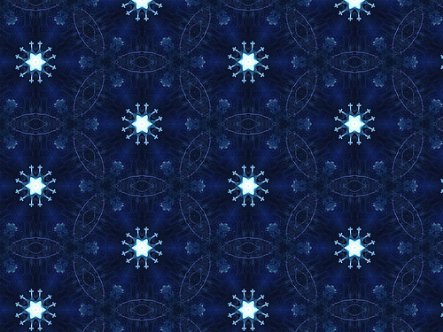Millennialist predictions vary as to what the transformations of 2012 are meant to be. For some, 2012 represents The End of the World, the apocalypse, the destruction of society, or even life as we know it. For others, 2012 represents an inflection point in human consciousness, a tipping point at which our age's accelerating growth in spiritual consciousness suddenly wins out over its equally perilous growth in material chaos and devastation.
In fact, this distinction — whether the "next age" is about spiritual transformation or material destruction — has long been a part of Western apocalyptic thinking. The latter tradition is better known: the Rapture, the End Times, the Apocalypse. However, the former tradition is also present in Christianity, Islam, and Judaism. In this essay, I want to share with you some of the Jewish traditions on the "spiritual view" of global transformation, and explore how it may indeed be underway today.
Because of Reality Sandwich's interest in 2012, I feel I should disclose that, as a longtime student of messianic and millennial movements (I am writing my doctoral dissertation on the 18th century messianic figure Jacob Frank), I remain a 2012 skeptic. There have just been too many Times of Transformation: 1666, 1848, Y2K (remember that?), and literally hundreds of others, now long forgotten. Then again, who knows? One of the benefits of the "spiritual view" is that it makes predictions less important. If 2012 is to be the time of global transformation of consciousness, then we'd be wise to get serious about spiritual practice now. If 2012 is not to be such a time, then we'd still be wise to get serious about spiritual practice — because we're gonna need it to survive. Okay — disclosure made.
To the sources, then. First, Judaism is both an historical and an ahistorical religion. Ahistorically, Jewish time is cyclical: the Sabbath comes every seven days, and our agriculturally timed cycle of holidays renews itself each year. This Judaism shares with other Earth-based religions. Historically, though, Jewish time is linear. We Jews tell stories of an ancient creation and hold hopes for a future redemption. We involve ourselves in history, in collective enterprises such as Zionism and individual ones such as righteous action on behalf of the less fortunate. For the Kabbalists, the cyclical and linear aspects of time represent the feminine and masculine aspects of Divinity, the power of Now and the trajectory of temporality.
One of Judaism's central historical tenets is the belief in a Messiah, a redeemer who in some future time will change, or even end, history. Jewish beliefs about the Messiah have themselves evolved over time. Initially, the Messiah was seen as a purely military/political leader who would bring independence back to Judea. Later, the Messiah became seen as a cosmic figure who would change the entire nature of reality. Likely under the influence of Christianity, the Messiah was sometimes seen as a semi-divine figure, even one who would atone for the sins of Israel. Because Jewish law is largely silent on matters of belief, all of these views have held sway at one time or another. Today, many Hasidim believe that the last Lubavitcher Rebbe will somehow return from "apparent" death to unite all the world. Many nationalists believe that an "inevitable" war in the Middle East will bring the Messiah. A handful of ultra-nationalists have even plotted to blow up the Dome of the Rock to get the party started. Fortunately, these remain a miniscule fringe.
In contrast to such traumatic and supernatural accounts of messianism, there has been a longstanding Jewish tradition to regard the messianic age as one of evolving consciousness rather than revolutionary history. This view has two major forms.
The first is what Gershom Scholem called the "neutralization" of Jewish messianism which took place in the Hasidic movement in the late 18th century. Contrary to Hasidism today, Hasidism then was a radical, spiritual renaissance. And it arose in the wake of a great historical trauma: the Sabbatean heresy, during which one-third of European Jews believed the Messiah had arrived and now walked the earth. After that Messiah converted (under duress) to Islam, the movement underwent a crisis. Many still believed; some followed their Messiah and converted outwardly to Islam, while remaining secretly Jewish. Many were disillusioned. But for most, the messianic impulse remained — and remained unfulfilled.
In response, Early Hasidism claimed that the messianic "world to come" could be experienced here and now, in moments of spiritual ecstasy. That is to say, "There is no Messiah, and You're It," in the words of the contemporary writer Rabbi Robert Levine. This redefinition of messianism, which has its roots in older Kabbalistic sources, largely de-historicizes the messianic age. In its most raw form, messianism becomes more a state of mind than anything else.
But there is also a second, hybrid form, which brings together the historical and the ahistorical elements. This view is expressed in the eighteenth-century Kabbalah of Rabbi Moshe Chaim Luzzatto ("Ramchal"), reflected in the writings of the founder of Hasidism, Rabbi Israel Baal Shem Tov, and refined in the work of the twentieth-century Rabbi Abraham Isaac Kook, that brings the ahistorical and the historical views of the messianic age together. The messianic age, these sources suggest, is a time at which the consciousness that all is God will fill the earth. And it is a time which will come gradually, as more and more people begin to transcend the illusions of the separate self and realize the truth of their natures. The contemporary Kabbalist Rabbi David Friedman writes, "According to Luzzatto, the messianic era (the ‘days of Messiah') is the culmination of one huge evolutionary learning process which was conceived with the Universe, born with the emergence of Life, and becomes mature when Humanity easily achieves Divine Inspiration, Ruach Hakodesh."
At its apogee, such a change in consciousness becomes an apotheosis, not through transfiguration but by an understanding of the divine state we inhabit already. This is how a nondualist rereads the prophet Joel 2:28: "And it shall come to pass afterwards, that I will pour out my Spirit upon all flesh; and your sons and your daughters shall prophesy. Your old men shall dream dreams, your young men shall see visions." And it is how one may understand the epistle of the Baal Shem Tov, in which the rabbi is told that the messiah will come "when your teachings become publicized and revealed to the world, and your wellsprings have overflowed to the outside . . . so that others, too, will be able to perform mystical unifications and ascents of the soul like you."
Notice too the language of "the wellsprings of your teachings are spread out" around the world. Naturally, the eighteenth-century rabbi despaired at this news: how distant it must have seemed to him! Yet today, we may understand it somewhat differently. The "wellsprings" of the Besht's teachings — that would be their source, not their final expression. And that source? That alzt is Gott, all is God, all is One, separation is illusion. And this source is indeed found throughout the world.
Imagine a world in which everyone understood that all of us are God. Not one in which each person thought he or she was God alone — that would be disaster. But one in which the nonduality of Being was understood, in some form or fashion, by all human beings. This would be an entirely different world from the one we now inhabit, free of the conflicts and crises, petty and grotesque, which fill our moment. And imagine what it would be like, right now, to believe that, as Ramana Maharshi has said, "civilization . . . will finally resolve itself, as all others, in the Realization of the Self" (Talks, p. 256).
Such a time is, of course, far-off. But this conception of the historical evolution of consciousness helps contextualize, explain, and enliven the development of religious consciousness from its most primitive to its most refined stages. Religious consciousness evolves, as Spirit comes to know itself in history (Hegel). We move through different stages of individual and communal religious consciousness, each at our own rates, according to a myriad of circumstances. But we move toward one non-supernatural Omega point (Teilhard de Chardin): the knowledge — the intimate knowledge — that all is One.
Now, in our postmodern information age, the noosphere (Teilhard de Chardin again) is indeed upon us. Already, thanks to global information technology, the hidden mystical teachings of the world's religious traditions are accessible to everyone, as are the great wealth of scientific, cultural, philosophical, and artistic works from the better part of humanity. But even this is just the beginning. The internet, nanotechnology, and wearable computers are but the initial stages of a noetic revolution in which nonmaterial information may displace material matter as the ultimate future of the body. Most probably, we are only a few decades away from being able to upload our minds onto renewable data media. Is this the "immortality of the soul" of which some religions once spoke? What is the meaning of humanity if we are able to transcend the limits of matter? And more proximately, what is the significance of this new knowledge, accessible all over the world — including, for our purposes, the highest truth (singular!) of so many spiritual traditions, that there is really no one either reading or writing these words?
The messianic age is already unfolding, in this interpretation, and the gradual emergence and dissemination of nonduality is among its signal phenomena. The wellsprings of the Baal Shem Tov's teachings have indeed spread out throughout the world; they are already flowing on every continent and in every city with unrestricted access to the internet. This changes things.
Indeed, the evolution in spiritual/religious consciousness is part of a larger process of evolution toward the "messianic" endpoint. One description of that process, found in the work of Ken Wilber, maintains that the general progression from stages of conventional consciousness to successive realms of unconventional consciousness (gross/nature mysticism to subtle/deity mysticism to causal/formless mysticism to nondual/both emptiness and form) mirrors the progressions of cultural systems, social structures, even the physical structures that compose the material corollaries to so-called spiritual experiences, and the orders of complexity of the material world. For Wilber, this progression can be represented as mineral>vegetable>animal>impersonal>personal>spiritual; for the Hasidim, it is domem>tzomeach>chai>medaber-inanimate, vegetable, animal, speech
What terrifies fundamentalists is that religious meaning evolves over time. Yet from an integral messianic perspective, that is exactly what it should be doing. There is no experience apart from interpretation, not merely because mystics must interpret their experiences according to the language and culture they know, but because those linguistic and cultural structures condition the nature of the experience itself. Perhaps "I" will "have" a "vision" of "angels," but all of the quoted terms are cultural constructions. The structural/historical conditioning of experience is unavoidable, so much so that it makes little sense to speak of "experience" or "God" or "mysticism" apart from the stages in which such experience is interpreted. Put simply, God looks different depending on where you stand.
From what Wilber (following the integral approach developed by the philosopher Jean Gebser) calls the magical stage, God looks like the provider who answers all of your (egocentric) needs. From the mythic stage, God — as understood in your faith tradition exclusively — is the sole source of salvation, and everyone who doesn't believe in Him is doomed. From the mental-rational stage, God is a moral principle and the Bible a useful, though flawed, teacher of ethical truths; other teachers may also be valuable. From the pluralistic stage, God is love, expressed in a thousand ways by a thousand religions, all deserving of respect. And from the various integral stages, God is variously Nothing, and all of the above.
Experiences of all types are available to all kinds of people. But the same experience will be immediately contextualized and interpreted according not only to one's religious/spiritual/scientific tradition but also one's "stage" of religious development. Perhaps an experience of light is a spirit, or an angel, or the Agent Intellect, or an opening to the Infinite — all interpretations of luminous internal light found within Jewish mystical sources. Or perhaps it is merely an experience, which opens the soul but which, in and of itself, is no closer to God than waiting in line at the post office. The point is not that there is a True God perceived in these partial ways; rather, these partial ways define what is meant by "God."
In the beginning, our ancestors were animists, and polytheists. They believed in "power gods," nature spirits, warrior deities, fertility goddesses. Eventually, some came to venerate one sky god above all others, insisting that all the Divine energies in the world were from a single source alone. Later, philosophical thinking refined these notions of this single source, away from an anthropomorphic deity and toward an impersonal Oneness. Mystics experienced the One in love, and in so doing resacralized the whole world as the veiling and unveiling of the Beloved. Everything became seen as the costume of God. When we gaze into the mirror of the Infinite, we cannot help but project the contents of our minds onto It. And all of these projections are partial truths.
Finally, if a transformation in spiritual consciousness is to take place — in 2012 or otherwise — it must by definition be an inclusive, integral, and non-triumphalistic one. In contrast to adolescent images of God (or gods), nondualistic integral messianism does not exclude other traditions and does not depict "earlier" stage religious experiences as variously imperfect approximations of this one true one. No patronizing allegorization of myth and narrative. No reductive confusion of the prerational with the transrational. Neither the offensively naive privileging of mythic-stage gender roles, nor the erasure of mythic power in the attempt at egalitarianism.
Utopian ideal? Exactly — and that is exactly the function of the messianic urge, here reconfigured away from nationalism, triumphalism, and supernaturalism, and toward the dawning of realization on earth. Will everyone be Christian or Gnostic or Jewish in the messianic age? Will a magical chariot descend from the sky? Of course not — that misses the entire point. Rather, the nondual wellsprings of the Baal Shem Tov's (and many other) teachings will water a thousand plants in Eden, a biodiversity of spirit which, as in ecology, nourishes the whole by supporting difference. Consciousness will shift until such a point at which even the lion may lie down with the lamb.
We don't have to wait until 2012 to begin doing this work. Imagine the great shabbat, the great resting and relinquishment, that could unfold if we really believed that all concepts are masks. Our certainties and pronouncements would be interrupted by little notes of uncertainty, of unknowing, of remembering that the mystery lies beyond our grasp and that even sacred totems are only best efforts. We return, perhaps unexpectedly, to a state of wonder-both at the One and at the Many. Speedily, in our days . . .
Image by Crystal Writer, courtesy of Creative Commons license.













